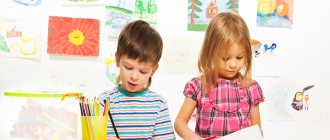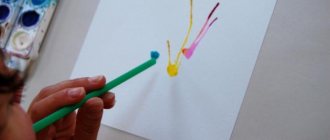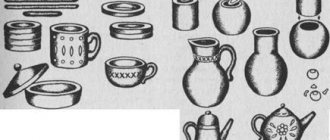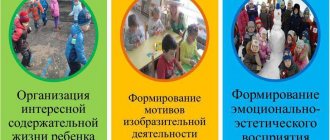“Methodology for conducting classes in visual arts in the middle group (drawing)
“Methodology for conducting classes in visual arts
in the middle group" (drawing).
Educator of the Municipal Preschool Educational Institution “DS No. 7”, Blagodarny, Stavropol Territory Radchenko N.I. (from work experience).
Fine creativity is a children’s activity that is aimed at the aesthetic development of the world through visual arts.
new art. The basis of the artistic image is the “three pillars” - emotionality, interest, activity (E.A. Flerina).
A child is a creator by nature; all children see the world around them in their own way. Therefore, as a teacher, I need to teach children to boldly and freely use methods of creating an image, to help them develop a creative personality. What is intrinsically valuable is not the final product - a drawing, but the development of personality: the formation of self-confidence in one’s abilities, self-expression in creative work, purposefulness of activity.
Fine arts classes require pedagogically thoughtful equipment. My group has everything necessary for drawing - this is: a board, an easel, stands; tools: colored pencils, simple pencils, felt-tip pens, watercolor paints, gouache, brushes of two sizes, crayons, wax candles, sponge, cotton swabs, sippy cups, fabric napkins.
The more diverse I create the conditions in which visual activity takes place, the content, methods and techniques of working with children, as well as the materials with which children act, the more intensely children’s artistic abilities will develop.
The content and methods of conducting visual arts classes are aimed primarily at developing creativity in children. To do this, I use artistic expression, music, and creating an emotionally positive mood in children.
To implement the tasks of artistic and aesthetic development of children in my group, I use the following methods and techniques:
- play as the main activity of children of middle preschool age;
— visibility as the leading pedagogical method;
- method of aesthetic persuasion and aesthetic choice;
— traditional methods of pedagogy: dialogue, guessing riddles, reading fiction;
— didactic games, exercises, game situations, finger games (development of fine motor skills);
— design of exhibitions of children's creativity;
— method of physical activity (physical training minutes, finger exercises, dynamic pauses);
- listening to a piece of music;
— co-creation method (with a teacher or peer);
— use of non-traditional techniques and materials.
Unconventional drawing gives children many positive emotions. Having learned to express his feelings on paper, the child overcomes shyness and fear that nothing will work out. He is confident that it will work out, and it will turn out beautifully.
Drawing lessons in the senior group
⇐ PreviousPage 10 of 18Next ⇒
Teaching children six or seven years old to draw is particularly difficult.
With proper guidance, children of this age acquire the ability to see more and observe better, which also requires corresponding fixation in drawing and requires new skills. In drawing, a critical attitude towards the results begins to manifest itself more and more.
The child’s attention and interests become broader and more stable. A conscious interest in learning is revealed. At the same time, the child still retains a number of features characteristic of the previous age: in drawing and sculpting, the child’s psychology of the accomplice of the person depicted still does not leave him, there is a temporary solution to the image (multi-episode nature, element of the game).
The child willingly strives to learn how to draw living objects that interest him, but he cannot learn “for future use” on abstract forms (geometric or geometric-like objects) (the visually simple turns out to be psychologically complex, and the child loses the taste for drawing).
In connection with the new capabilities of six-seven-year-old children, the guidance of children's drawing becomes more systematic, and learning tasks become more complicated.
Learning Objectives:
1. Development of the content of children's creativity and deepening of the relationship to what is depicted.
2. Development of consciousness and elements of planning in work.
3. Development of form (transition from schematic form to elements of realistic form).
4. Work on the composition of the drawing (filling the sheet, feeling the center, edges, highlighting the main thing).
5. Work on color (bold, bright use of color in a realistic form, transition to local coloring).
6. Development of decorative creativity (along the lines of geometric and floral patterns).
7. Work on improving children's drawing techniques (good pressure, bold lines, intense pace of work, correct use of material, correct techniques in working with a brush, shading with colored pencils, etc.).
Types of children's drawing
Drawing guidance for older children should cover all types of drawing, clearly defining what and how the child should be taught.
Thematic tasks of a subject nature (increasing the complexity of the form) are preceded by appropriate observations, during which the main characteristics of objects are determined, their qualitative characteristics are developed, and the ability to see essential details is developed. When looking at decorative objects and samples, children not only express an emotional attitude towards beauty, but also try to answer the questions of what is beautiful and why it is beautiful. Increasing the analysis of observation increases awareness in the drawing process.
Subject-thematic tasks (people, animals, houses, transport, nature, etc.) are alternated and repeated with gradually increasing complexity of the task. For example: 1) a person in full sheet with a depiction of his main features (colored pencils); 2) a man in a paper cut (applique); 3) person more
correct shape; 4) family (observance of scale in the depiction of adults and children, costume); 5) a person in different clothes (of different nationalities, professions); 6 people
in various turns (front, profile, rear); 7) demonstration on May 1 - a lot of people, their location on the sheet (complex tasks are carried out in two lessons).
Tasks on a broad topic, requiring the accumulation of relevant impressions, observations, and “free” drawing, alternate with tasks on a subject topic, strengthening the skills acquired by performing narrower tasks, developing the need to creatively express life topics that concern children (nature, everyday life, social moments). At the same time, significant attention is paid to the use of artistic images, the child’s attitude towards them, and the deepening of the child’s moral experiences in connection with drawing.
Decorative work of a child. In one case it may be more, in another less, regulated by the teacher’s tasks. Here the nature of the drawing is predetermined, but its specific, pictorial, ornamental content is invented by the child. Decorative drawing can be on paper and on real objects (fabric, papier-mâché).
Elements of learning must take place in all of these types of drawing, but the content and nature of the learning varies depending on the type of activity.
Drawing of a utilitarian, auxiliary nature. For example, drawing to help with writing (a pattern consisting of letter elements) or drawing in connection with math activities (counting with drawn objects).
Guiding drawing according to the child’s intentions is of great importance. Left without guidance, drawing by design quickly loses its charm for the child, because the quality of the drawing ceases to satisfy him. The teacher's respect and attention to this type of children's creativity, exactingness regarding its quality, individual assistance in the process of work, periodic critical viewing of their works with children have a positive effect on drawing according to the children's intentions.
Drawing, as intended by children, should remain to a large extent in the older group as a means of creative expression of children's ideas, interests, and experiences; he should be given enough time and sensitively guided. It is necessary to thoughtfully develop the child’s broad creative initiative, which is fully revealed in this type of drawing.
Conditions and prerequisites for experimental work.
We worked on the problem of teaching children of the senior group fine arts in general and drawing in particular in a number of kindergartens in Moscow and the Moscow region for 9 years (from 1939-1948). At the same time, massive material was collected during teaching practice by students of the Moscow State Pedagogical Institute named after V.I. Lenin. In addition, methodological materials of the City Methodological Office of Moscow and the Moscow Region, kindergartens in Tambov and Tashkent were studied.
The main methods of our work were: observation of practice and setting up a pedagogical experiment.
By organizing a pedagogical process that is most conducive to the full expression of a child’s creativity, we sought to determine a program and methodology for teaching children drawing and modeling.
In addition to preliminary theoretical work, establishing basic hypotheses and prerequisites, and developing a plan for the entire experiment, we carried out systematic work with the staff of these kindergartens, which ensured the interest of educators in the experimental work and improved the quality of their work.
The work of guiding and teaching drawing and modeling to children of the older group was carried out by us personally systematically in kindergarten No. 4 of the Kuibyshevsky district and in kindergarten No. 2 of the Dzerzhinsky district, as well as partially in the “Muraveinik” orphanages (Udelnaya station). It was carried out in almost every drawing and modeling lesson from October to the summer.
All tasks were planned and discussed with the group workers, the head of the kindergarten and the head of the pedagogical department. Periodically, reports were given to the entire kindergarten staff on the topics: “Elements of teaching drawing”, “Specifics of guidance in each age group and characteristics of children’s creativity”, “Guidance in drawing on a free topic”, “Guidance in drawing on assignment”, “Decorative drawing of children”, “Development of observation skills”, etc. The results of each lesson with children were discussed with the teacher, the head of the pedagogical department and the head of the kindergarten.
All the work we have done on teaching children to draw was completed in the long-term experimental work of kindergarten No. 4.
For the experiment, we selected an older group, which was a rather difficult subject for this purpose: these were children of six or seven years old who had not received proper guidance. The group consisted of 15 boys and 16 girls; only some of the children transferred from the middle group (12 people), the rest of the children were new, from the family (9 people), 10 people were transferred from other kindergartens - this complicated the work. The children showed no interest in drawing. There were cases when some children, seeing that the teacher was preparing a drawing lesson, tried to sneak out of the group, linger in the corridor, or run into the neighboring group. The following remarks were often heard from children: “Is it possible not to draw?”; “I don’t know what to draw”; "I can't"; “I’d rather write,” etc. The children drew sloppily, reluctantly, trying to finish quickly in order to get off as quickly as possible. At the same time, the children of the group, with a few exceptions (2-3 children), were well-developed: they knew a lot, their interests were varied, their speech was quite developed, they talked with pleasure, they knew a lot of children's books, they extremely loved listening to stories and especially fairy tales. The children's games were varied and they played a lot. In manual skills and activities, they certainly lagged behind. They were very critical of each other’s work: mocking remarks were often heard in the group, which discouraged and reduced the interest of those drawing.
It was necessary to overcome the gap between understanding and skill, and lack of confidence in one’s abilities, and a frivolous, disinterested attitude towards drawing in general. We thought a lot about how to achieve success, where to start, what tasks to put forward for the first period of work.
The first prerequisite for setting up the experimental work was our conviction that the success of children's creative work can only be built on the teacher's interested attitude towards it, his faith in the child's strength, his attention and desire to provide the children with the necessary help, and systematically guide the children's work. To this end, we conducted systematic consultations and reports with teachers, planned and analyzed each lesson.
The second premise was the belief that children aged six or seven would want to learn and should be dealt with openly. This question needs to be raised directly with children. But education at this age is unique, and it should be based on the child achieving some similar goals. Insufficient stability of children's attention and poor endurance do not allow the child to work long and persistently on a distant goal. The results should be close in time; the job should have small, uncomplicated tasks with a visible accomplishment. You need to start from this, gradually complicating the tasks.
The third prerequisite was the conviction that one of the main elements in the work of drawing is the observation of beauty in nature, in everyday life, in art. A culture of observation will ensure interest and attention to expressive form, to color, to works of art accessible to the child, will deepen interest in one’s own drawing, and will ensure an improvement in its quality. The first stage of work is to gain children's attention and interest in drawing, changing children's attitude towards drawing. The work went in two directions: 1) setting children small drawing tasks and 2) developing children's observation skills. We found it advisable to give tasks that would not be very difficult or productive, but that would force the children to complete them responsibly. Decorative drawing and a number of themes for depicting close, beloved objects by children provided us with great service.
We foresaw that the children would not immediately respond to our assignments. And indeed, the children listened with surprise to the teacher that now we will begin to learn to draw little by little, that, of course, having learned, we will stop saying “I can’t”, that you can learn to draw whatever you want, and, of course, everyone’s drawings gradually They will become better and better, it is important to draw seriously, etc. After listening quite carefully to the teacher’s introduction, which was unusual for them, the children began to draw with paints on colored sheets of paper.
The task was this: take the colors you like, and boldly, brightly decorate the sheet, as you wish - with bright spots, stripes, flowers, cells, dots, just to boldly, brightly paint it. We planned this particular activity, since it did not require children to draw any objects; it attracted attention with its colorfulness and at the same time set a certain task for the children. We believed that completing this task would give the children some satisfaction.
As we foresaw, despite the simplicity of the task, the children’s indecision was immediately revealed. What was unusual for the children was the rather rich palette of colors (gouache diluted in clean cups), the colorful, rather large sheets of paper, and the interest of the teacher. The hand was not used to bold movements. The children timidly took the paint on the brush: “Oh, I’ll ruin the paper!”; "I can't"; “Show me how to paint”; “I don’t know what kind of paint I should take,” etc. During the work, the teacher gave instructions, encouraged the children, and advised; his tone was confident. Gradually the children got the hang of it, fell silent, drew, but then looked hesitantly at the teacher; many shyly hid their drawings from their comrades. The picture was unusual: almost all the children drew for 30 minutes, and then began to look with surprise at the drawings of their comrades. We considered the experiment a success and decided to repeat it periodically. These drawings were reviewed with the children at the end of the lesson. Many of the drawings turned out to be bright and attractive. The children themselves were pleasantly surprised. They talked animatedly, noted at the teacher’s suggestion what was good, what drawing would be good to correct, what color to choose, etc. Some children willingly began to “complete” their drawings.
In parallel with decorative tasks, children were offered thematic tasks of two types: a) a separate image and b) broad themes. Tasks of the first type put forward a certain requirement for the children that was new to them. These were not broad themes with rich plot content, it was a separate image; the tasks were predominantly of a subject nature (“transport”, “person”, “steamboat”, “house”, “trees”, etc.). These tasks were prepared and carried out differently. They were preceded by specially organized observation and examination of these objects. In addition, the teacher selected photos, pictures, toys and gave them to the children to look at. This purposeful accumulation of impressions and observations had a great influence on children’s drawing.
When drawing a separate image thematically, at first the children were asked to complete one or another simple task. For example, draw an object in a fairly large size, move your hand boldly, quickly, paint carefully. As a rule, such drawings were collectively discussed with the children. The positive results in the children’s work were significantly facilitated by the teacher’s attitude to work, his exactingness and clarity of the task. The teacher's genuine interest, his attention to the child's difficulties and the joy of success encouraged and inspired the children. Trust in the child's strengths contributed to significant success, especially among weaker children.
Over the course of the month, the children's attitude towards drawing changed dramatically in a positive direction. Not only did they not avoid the activity, but they themselves asked: “When to draw?”; “What are we going to draw?”; willingly participated in the preparation of material for the lesson. While drawing, the teacher taught the children the technique of using paper and paints, indicated in which cases which brush should be used to paint (for small work, when painting details - with a thin brush; when painting large surfaces - with a thicker brush; how to thoroughly rinse and wipe the brush, etc. . P.). The children used these instructions, looked after themselves and their comrades, and often reminded each other what to do in this or that case. So Inna says to Mansur: “You spend a whole hour fiddling with a small brush. That’s what they taught – take the big one.” Another girl, Valya, while cutting out, instructs her neighbor: “Cut here, on the edge, you’ll ruin the sheet, then you won’t have enough paper yourself.”
⇐ Previous10Next ⇒
Recommended pages:
Use the site search:







